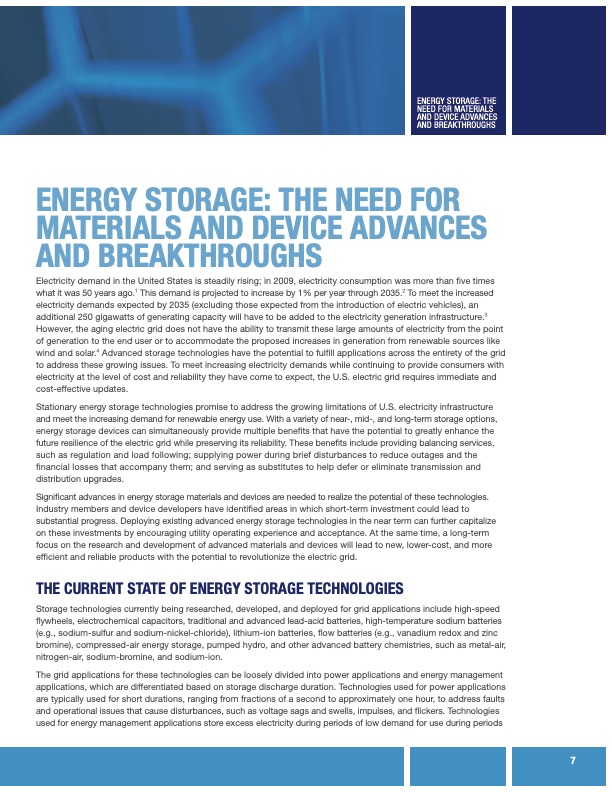
PDF Publication Title:
Text from PDF Page: 011
ENERGY STORAGE: THE NEED FOR MATERIALS AND DEVICE ADVANCES AND BREAKTHROUGHS Electricity demand in the United States is steadily rising; in 2009, electricity consumption was more than five times what it was 50 years ago.1 This demand is projected to increase by 1% per year through 2035.2 To meet the increased electricity demands expected by 2035 (excluding those expected from the introduction of electric vehicles), an additional 250 gigawatts of generating capacity will have to be added to the electricity generation infrastructure.3 However, the aging electric grid does not have the ability to transmit these large amounts of electricity from the point of generation to the end user or to accommodate the proposed increases in generation from renewable sources like wind and solar.4 Advanced storage technologies have the potential to fulfill applications across the entirety of the grid to address these growing issues. To meet increasing electricity demands while continuing to provide consumers with electricity at the level of cost and reliability they have come to expect, the U.S. electric grid requires immediate and cost-effective updates. Stationary energy storage technologies promise to address the growing limitations of U.S. electricity infrastructure and meet the increasing demand for renewable energy use. With a variety of near-, mid-, and long-term storage options, energy storage devices can simultaneously provide multiple benefits that have the potential to greatly enhance the future resilience of the electric grid while preserving its reliability. These benefits include providing balancing services, such as regulation and load following; supplying power during brief disturbances to reduce outages and the financial losses that accompany them; and serving as substitutes to help defer or eliminate transmission and distribution upgrades. Significant advances in energy storage materials and devices are needed to realize the potential of these technologies. Industry members and device developers have identified areas in which short-term investment could lead to substantial progress. Deploying existing advanced energy storage technologies in the near term can further capitalize on these investments by encouraging utility operating experience and acceptance. At the same time, a long-term focus on the research and development of advanced materials and devices will lead to new, lower-cost, and more efficient and reliable products with the potential to revolutionize the electric grid. THE CURRENT STATE OF ENERGY STORAGE TECHNOLOGIES Storage technologies currently being researched, developed, and deployed for grid applications include high-speed flywheels, electrochemical capacitors, traditional and advanced lead-acid batteries, high-temperature sodium batteries (e.g., sodium-sulfur and sodium-nickel-chloride), lithium-ion batteries, flow batteries (e.g., vanadium redox and zinc bromine), compressed-air energy storage, pumped hydro, and other advanced battery chemistries, such as metal-air, nitrogen-air, sodium-bromine, and sodium-ion. The grid applications for these technologies can be loosely divided into power applications and energy management applications, which are differentiated based on storage discharge duration. Technologies used for power applications are typically used for short durations, ranging from fractions of a second to approximately one hour, to address faults and operational issues that cause disturbances, such as voltage sags and swells, impulses, and flickers. Technologies used for energy management applications store excess electricity during periods of low demand for use during periods ENERGY STORAGE: THE NEED FOR MATERIALS AND DEVICE ADVANCES AND BREAKTHROUGHS 7PDF Image | Devices for Stationary Electrical Energy Storage Applications

PDF Search Title:
Devices for Stationary Electrical Energy Storage ApplicationsOriginal File Name Searched:
AdvancedMaterials_12-30-10_FINAL_lowres.pdfDIY PDF Search: Google It | Yahoo | Bing
Turbine and System Plans CAD CAM: Special for this month, any plans are $10,000 for complete Cad/Cam blueprints. License is for one build. Try before you buy a production license. More Info
Waste Heat Power Technology: Organic Rankine Cycle uses waste heat to make electricity, shaft horsepower and cooling. More Info
All Turbine and System Products: Infinity Turbine ORD systems, turbine generator sets, build plans and more to use your waste heat from 30C to 100C. More Info
CO2 Phase Change Demonstrator: CO2 goes supercritical at 30 C. This is a experimental platform which you can use to demonstrate phase change with low heat. Includes integration area for small CO2 turbine, static generator, and more. This can also be used for a GTL Gas to Liquids experimental platform. More Info
Introducing the Infinity Turbine Products Infinity Turbine develops and builds systems for making power from waste heat. It also is working on innovative strategies for storing, making, and deploying energy. More Info
Need Strategy? Use our Consulting and analyst services Infinity Turbine LLC is pleased to announce its consulting and analyst services. We have worked in the renewable energy industry as a researcher, developing sales and markets, along with may inventions and innovations. More Info
Made in USA with Global Energy Millennial Web Engine These pages were made with the Global Energy Web PDF Engine using Filemaker (Claris) software.
Sand Battery Sand and Paraffin for TES Thermo Energy Storage More Info
| CONTACT TEL: 608-238-6001 Email: greg@infinityturbine.com | RSS | AMP |